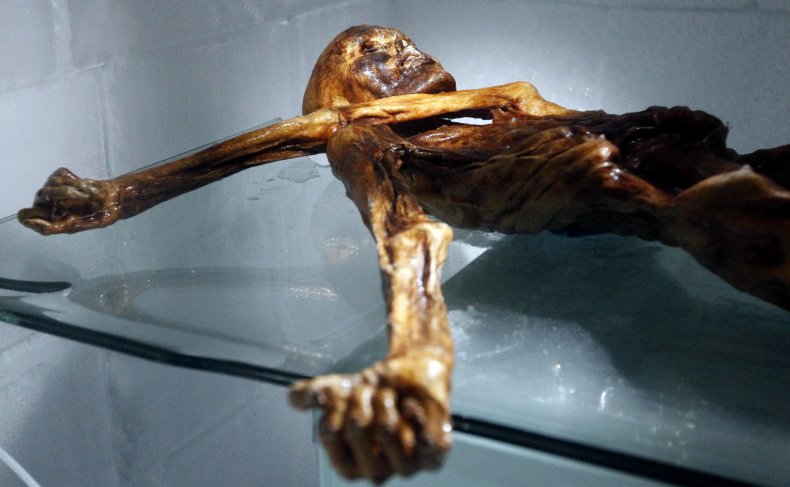Otzi the Iceman Makes a Fashion Stament
Aboriginal Plants Plant on Ötzi the Iceman'south Clothes Offer Clues to His Final Journey
Researchers are attempting to piece together Ötzi the Iceman's last journey—and are using ancient moss to do it.
Archaeobotanists at the University of Glasgow in Scotland, United kingdom, accept identified more than than 75 species of bryophytes (not-vascular plants that include mosses and liverworts) frozen alongside Ötzi approximately five,300 years ago. The results have been published in PLOS One.
"They were recovered equally mostly minor scraps from the ice around him, from his clothes and gear, and even from his comestible tract," James Dickson of the University of Glasgow, Great britain, said in a statement.
"Those findings prompted the questions: Where did the fragments come from? How precisely did they get there? How do they assistance our understanding of the Iceman?"
Dickenson and colleagues found that 21 of the bryophyte species identified were likely to have originated shut to the site of Ötzi's body, at the top of the Tisenjoch laissez passer in the Ötztal Alps near to the Italian-Austrian border. However, some of the other the other bryophyte species identified would have originated from elsewhere, including areas at lower elevations.
In total, they believe approximately 30 percent would have been local species. The other 70 percent would accept been carried past Ötzi in his gut or vesture—or from the debris of large mammalian herbivores.
The origin of these plants suggests Ötzi traveled along the Schnalstal Valley, an alpine route that stands at 500 to 3,200 meters (1,640 anxiety to 10,500 feet) to a higher place sea level with balmy climates and apple orchids at i terminate and glaciers at the other. Previous research identifying the origin of the pollen ingested by Ötzi supports this conclusion.
"These final journeys lend new weight to the 'disaster' theory of Ötzi'southward death, which suggests that, returning from the high alpine pastures to his native hamlet, he came into a severe conflict with his kin such that he had to abscond from the customs back to the high ground familiar to him, where he died," the written report, published in Quaternary Science Reviews in 2007, stated.

What practise we know nigh Ötzi the Iceman?
Ötzi the Iceman is remarkably well-preserved to the bespeak where his tattoos are even so discernible and his final meals can be identified (Alpine ibex and cherry deer meat), simply well-nigh of his life remains a mystery.
His torso was found in 1991 aslope clothing and equipment. The latter included a bow and arrows, a fire-making kit stored in a belly handbag and a copper-headed ax of southern Tuscan origin.
Examination of Ötzi 's trunk suggests he was in his mid-40s when he died. Scientists believe he bled to death afterward an pointer punctured the dorsum under his left shoulder.
His body shows other signs of injury (some fresh and some quondam), including a frost-bitten toe and broken ribs. There are also signs that he suffered from diverse ailments during his lifetime, including gallstones and whipworms.

0 Response to "Otzi the Iceman Makes a Fashion Stament"
Post a Comment